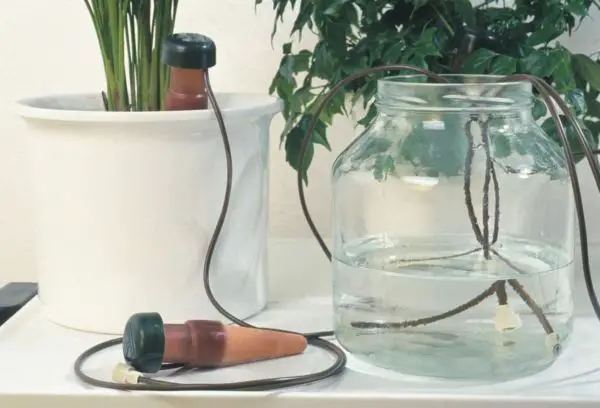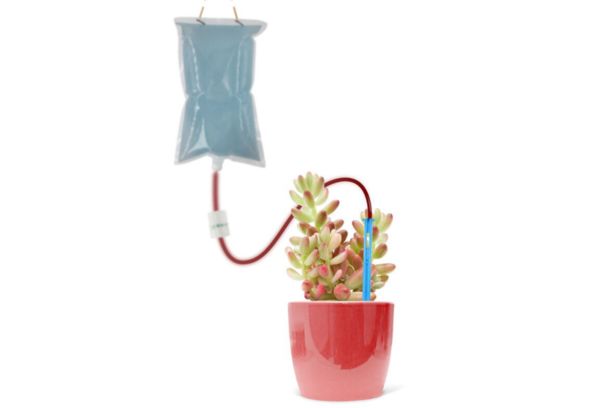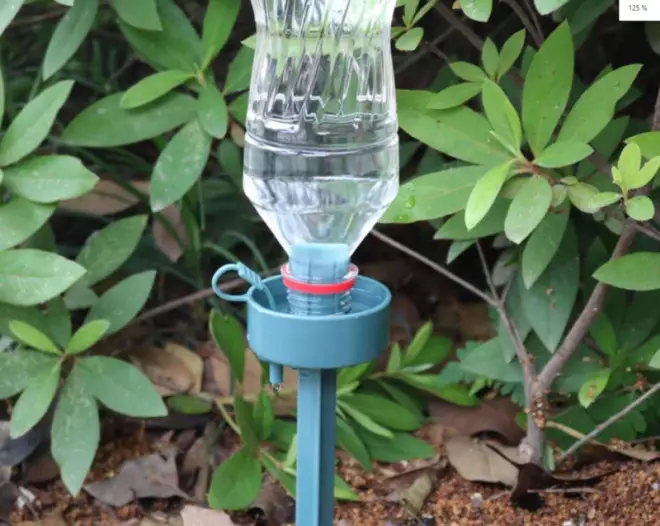You don’t have indoor plants and flowers because you often go on business trips? want to DIY self-watering system for indoor plants and you will forget about the worry that your favorite flower may die of thirst in your absence. Instructions for organizing auto watering will also be useful for those who do not know who to entrust to look after the flower collection during the holidays.

DIY self-watering system for indoor plants
how to water plants when away for a month?
My neighbor did not take over the authorship of this idea but said that he saw a video on the Internet, which describes in detail the simple process of making drip irrigation for indoor flowers. He has already organized such a system at home, and now he and his wife can live at the dacha for weeks without worrying about the plants left in the city apartment.
I also decided to use this option, although I am not very friendly with technology. This time everything worked out great for me. I share with you a life hack, I hope it will be useful to someone. Before proceeding, prepare everything you need:
- plastic bottle;
- corrugated cocktail tubes;
- soldering iron or screwdriver;
- glue gun with hot glue.
Automatic watering is done individually for each home flower. You will need as many plastic bottles as there are green pets in your apartment. The container volume can be different. If your absence will last no longer than a few days, a liter bottle will suffice. Absent for a couple of weeks, you will need to stock up on a larger capacity (well, at least a five-liter bottle).
Check also Best Mulch For Indoor Plants
Step by step instruction for DIY self-watering system
You can make a self-watering system in a few minutes. I tell you how to proceed step by step:
- First, make 2 holes in the wall of the bottle (one above the other). The bottom should be 2 cm above the bottom. To make the holes the right size (look at the diameter of the straw) and with smooth edges, use a soldering iron or a screwdriver heated over a fire. Make the second hole 1 cm higher than the first.
- Apply hot melt glue to one of the straws and place its tip in the bottom hole so that the length of the straw that ends up in the bottle is quite long.
- Insert the second (upper) straw into the other hole (its tip should be shorter inside) and also fix it with hot glue.
- Now cut the outside of the first tube shorter, and keep the second (top) longer. The corrugated part of the straws should be outside, due to this it will be easy for them to give the desired position.
Hot melt glue hardens almost instantly, the bottle is now ready for use. Fill it with settled water for irrigation, after clamping the ends of the tubes with clerical clips, “frogs” so that the liquid does not pour out. Then screw the cork onto the neck of the bottle.
how do self watering plants work?
The work of such a device from a bottle is explained by the laws of physics. Place the self-watering system next to the flower pot, directing the straws to the tray. As soon as you remove the clamps from each straw, water will flow from the bottom, and the top will begin to suck in air. When the water level in the sump reaches the spout of the top tube, air stops flowing into the bottle and water stops flowing.
At the moment when the roots of the flower draw moisture out of the pallet, the system turns on again and supplies a new portion of moisture. Please note that this method is only suitable for moisture-loving plants, the roots of which do not suffer from waterlogging. This list includes cyperus, bamboo, drooping reed, calla, rump, nephrolepis, spathiphyllum, balsam. The heat increases the water requirements of these plants. For other indoor flowers, other automatic watering methods are more suitable.
May also like Shade Loving House Plants
DIY self-watering droppers for indoor plants
Many people use medical droppers in their garden. They can also be used for watering indoor flowers in the absence of the owners. The method is similar to the wick self-watering system. In this case, you don’t have to tinker with anything:
- Fix one end of the dropper tube near the ground surface.
- The opposite part of the tube with the attached weight is lowered into a vessel with water, which should be placed above the pot.
- You open the system by adjusting the water supply with a tap.

In your absence, water will enter the soil in micro doses. Practice adjusting the system; the moisture supply should be such that the soil does not become overmoistened. Using a large bucket as a container, in this way you can water several plants at once. Of course, each pot must have its own dropper.
self watering wick cord for indoor plants
Wick irrigation is based on the principle of using a capillary system. Some people use the wick for this purpose all the time, but this method is only suitable for small plants, such as violets. If you are suddenly going to the seaside, you can temporarily transfer to wick watering all the flowers in the house.
Another limitation is related to the fact that the soil in pots, where this method of irrigation is used, must be loose. Usually, a moisture-permeable substrate contains peat or vermiculite granules. Only in this case, the water will wet the earthen lump well. For large plants, you will need not 1, but 2-3 wicks per pot.

The cord must absorb water well. Better to use a synthetic fiber rope. It is very easy to check the moisture permeability of the cord. Put it in a cup filled with water and watch how quickly it sinks. If the cord immediately sank to the bottom, then it can be used as a wick. Wick watering is convenient because several plants can be fed from one container at once:
- To arrange the supply of moisture, lower one end of the cord into a container of water on the windowsill.
- Attach the other end of the rope to the ground or lightly dig in.
- Adjust the water flow rate by changing the height of the container. If you raise the vessel higher, the water will flow faster. And vice versa.
Do not use natural fiber rope as a wick. From moisture, it begins to rot and ceases to conduct water efficiently.
Check it out why do indoor plants need direct sunlight?
self watering plants with plastic bottles
The simplest sprinkler can be made from a regular plastic bottle without any additional tools. Many people know this method again from the garden.

How to organize it:
- Cut the bottom off a clean 2 liter bottle. You will pour water into the resulting funnel.
- Make a small hole in the cork using an awl or drill.
- Screw the cap onto the neck of the bottle, after covering it with a layer of gauze to prevent clogging. The gauze should be firmly pressed against the lid, filling the thread.
- Turn the finished sprinkler upside down and dig it into the top layer of the soil or hang it so that the lid almost touches the ground.
It remains only to fill the bottle with water and moisture will seep into the ground drop by drop. It is understood that the number of plastic bottles will equal the number of pots. For small pots, use smaller bottles.
Purchased flasks
You have probably seen colored plastic flasks in gardening stores, painted to look like funny faces with a long narrow nose. So, they are used just for automatic watering. Additionally, the devices serve as an original decoration. Pour clean, settled water into each such flask and stick it into the pot with the plant, nose down.
According to the laws of physics, water will not flow into damp earth. Moisture will begin to gradually flow out of the flask when the soil dries out. Due to the small volume of cones during your long absence, this method will not help. However, flowers can survive the separation from you for several days even in the heat.
Check best large indoor plants for beginners
Can water beads be used to water plants?
You can provide plants with the necessary moisture reserve using a hydrogel. Its granules first absorb a large amount of water, and then gradually transfer it to the plant roots. Whether to use this method is up to you. It is quite laborious, but the pots look aesthetically pleasing without any overhanging “adaptations” and containers with water cluttering the windowsill.
Although, if no one visits the apartment in your absence, this circumstance does not matter. In this case, however, you will have to spend money on miraculous granules. They transfer the pots into more bulky containers, which may need to be purchased.
How to do it correctly:
- Before leaving, move each flower together with a lump of earth into a larger pot, having previously sprinkled a layer of hydrogel 4-5 cm thick on the bottom of the container.
- Fill the voids on the sides with granules, while tapping on the walls.
- Then pour over the soil and hydrogel liberally, pouring in water gradually, allowing it to be absorbed.
- Then cover the surface with plastic wrap to prevent moisture from evaporating too quickly.
By the way, the hydrogel belongs to reusable materials; it can be used after transplantation for a long time. This option is convenient for summer residents who live on the site all summer and visit a city apartment from time to time. You can remove the hydrogel later, during the next transplant. This material is inert and does not harm flowers at all.
watering tray with capillary matting
This novelty is a great help for flower growers who are unable to regularly water their houseplants. The capillary mat is a mat made of hygroscopic material. For watering, you need two large pallets of such dimensions that one fits into the other. Pour water into the lower tray. On top, place a second tray with holes made in the bottom, on which place one or more capillary mats (depending on the area of the tray).
Summery
You can use any method for the DIY self-watering system for indoor plants when you are away from home no matter for days, weeks and months. Use a suitable one for you with certain requirements.
